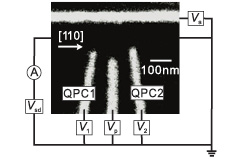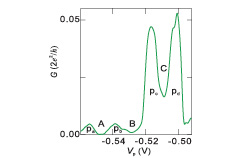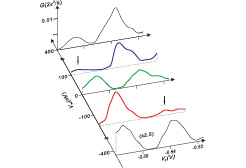Spin-Filtering and Detection in a Non-Magnetic Semiconductor Quantum Structure
Katsumoto Group
A key technology in semiconductor spintronics is the creation of spin-current. Especially the creation without the aid of ferromagnetism is a most important issue if one aims at the manipulation of quantum information associated with electron spins because ferromagnetism can be a strong source of quantum decoherence. In order to create spin polarization in a non-magnetic material, some mechanism to break the time-reversal symmetry is required. The combination of a current flow through a quantum point contact (QPC) and the spin-orbit interaction can work as such a device. The former works as a source of time-reversal symmetry breaking and the latter as a transducer to the spin-degree of freedom. The detection of spin polarization is also a problem to be solved. We have confirmed that a QPC in a material with a strong spin-orbit interaction can really work as a spin polarizer and a quantum dot (QD) can work as a sensitive detector.

Fig. 1. Scanning electron micrograph of the gate configuration for the quantum dot defined in a 2DEG of an In0.1Ga0.9As. White regions indicate the Schottky gates made of Au-Ni.

Fig. 2. Four successive Coulomb conductance peaks of the QD. Apparently they are classified into two pairs, which is the result of the Kramers degeneracy. The pair with higher conductance is showing conductance enhancement in the valley region due to the Kondo effect.

Fig. 3. Anti-symmetric disappearance of the Coulomb peaks with the application of the source-drain voltage to the QD (Red and blue curves. Indicated by vertical arrows).
A two-dimensional electron gas (2DEG) in an In0.1Ga0.9As film was epitaxially grown on a GaAs substrate. The spin-orbit interaction in InGaAs is known to be much stronger than that in GaAs. A QD, which is composed of two QPCs and a center plunger gate was defined with metal Schottky gates. The gate configuration is shown in Fig.1. The conductance through each QPC was quantized with the unit of e2/h, which is half of the usual quantization unit. This "half-quantization" is a sign of spontaneous spin-polarization.
In order for the confirmation with a more spin-specific phenomenon, the Coulomb oscillation in the QD was measured. In Fig.2, we observe two pairs of the Coulomb conductance peaks, one of which is much higher than the other. This is due to the appearance of the Kondo effect, which manifests at the same time that the Coulomb valley (the intermediate region between the two peaks) has a spin 1/2 or an odd number of electrons.
Now knowing the spin states in the Coulomb valleys, we turn our attention to the other pair of conductance peaks. As shown in Fig.3, one of the peaks diminished with applying a source-drain voltage (Vsd) to the QD while the other peak diminished with a source-drain voltage with the opposite sign. The twin-peak structure was recovered with further increase of the voltage. This anomalous behavior of the Coulomb peaks on the source-drain voltage can be explained in detail with assuming that the spin filtering effect. In other words, the anti-symmetric disappearance of the Coulomb peaks evidences the spin-filtering effect through a QPC with the spin-orbit interaction.
References
- [1] S. W. Kim, Y. Hashimoto, Y. Iye, and S. Katsumoto, J. Phys. Soc. Jpn. 81, 063004 (2012).
